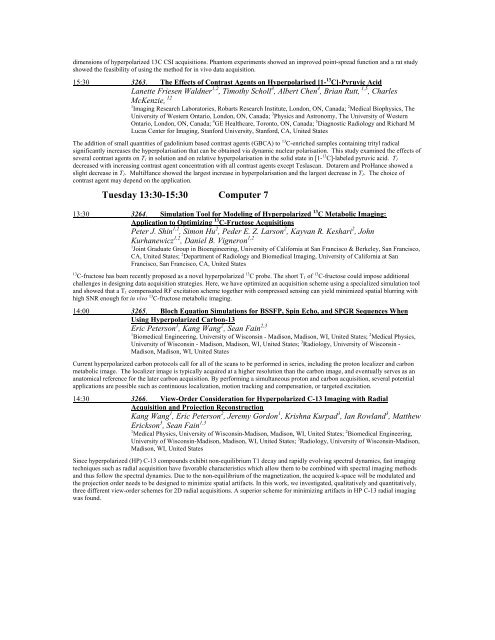ELECTRONIC POSTER - ismrm
ELECTRONIC POSTER - ismrm
ELECTRONIC POSTER - ismrm
Create successful ePaper yourself
Turn your PDF publications into a flip-book with our unique Google optimized e-Paper software.
dimensions of hyperpolarized 13C CSI acquisitions. Phantom experiments showed an improved point-spread function and a rat study<br />
showed the feasibility of using the method for in vivo data acquisition.<br />
15:30 3263. The Effects of Contrast Agents on Hyperpolarised [1- 13 C]-Pyruvic Acid<br />
Lanette Friesen Waldner 1,2 , Timothy Scholl 3 , Albert Chen 4 , Brian Rutt, 1,5 , Charles<br />
McKenzie, 12<br />
1 Imaging Research Laboratories, Robarts Research Institute, London, ON, Canada; 2 Medical Biophysics, The<br />
University of Western Ontario, London, ON, Canada; 3 Physics and Astronomy, The University of Western<br />
Ontario, London, ON, Canada; 4 GE Healthcare, Toronto, ON, Canada; 5 Diagnostic Radiology and Richard M<br />
Lucas Center for Imaging, Stanford University, Stanford, CA, United States<br />
The addition of small quantities of gadolinium based contrast agents (GBCA) to 13 C-enriched samples containing trityl radical<br />
significantly increases the hyperpolarisation that can be obtained via dynamic nuclear polarisation. This study examined the effects of<br />
several contrast agents on T 1 in solution and on relative hyperpolarisation in the solid state in [1- 13 C]-labeled pyruvic acid. T 1<br />
decreased with increasing contrast agent concentration with all contrast agents except Teslascan. Dotarem and ProHance showed a<br />
slight decrease in T 1 . MultiHance showed the largest increase in hyperpolarisation and the largest decrease in T 1 . The choice of<br />
contrast agent may depend on the application.<br />
Tuesday 13:30-15:30 Computer 7<br />
13:30 3264. Simulation Tool for Modeling of Hyperpolarized 13 C Metabolic Imaging:<br />
Application to Optimizing 13 C-Fructose Acquisitions<br />
Peter J. Shin 1,2 , Simon Hu 2 , Peder E. Z. Larson 2 , Kayvan R. Keshari 2 , John<br />
Kurhanewicz 1,2 , Daniel B. Vigneron 1,2<br />
1 Joint Graduate Group in Bioengineering, University of California at San Francisco & Berkeley, San Francisco,<br />
CA, United States; 2 Department of Radiology and Biomedical Imaging, University of California at San<br />
Francisco, San Francisco, CA, United States<br />
13 C-fructose has been recently proposed as a novel hyperpolarized 13 C probe. The short T 1 of 13 C-fructose could impose additional<br />
challenges in designing data acquisition strategies. Here, we have optimized an acquisition scheme using a specialized simulation tool<br />
and showed that a T 1 compensated RF excitation scheme together with compressed sensing can yield minimized spatial blurring with<br />
high SNR enough for in vivo 13 C-fructose metabolic imaging.<br />
14:00 3265. Bloch Equation Simulations for BSSFP, Spin Echo, and SPGR Sequences When<br />
Using Hyperpolarized Carbon-13<br />
Eric Peterson 1 , Kang Wang 2 , Sean Fain 2,3<br />
1 Biomedical Engineering, University of Wisconsin - Madison, Madison, WI, United States; 2 Medical Physics,<br />
University of Wisconsin - Madison, Madison, WI, United States; 3 Radiology, University of Wisconsin -<br />
Madison, Madison, WI, United States<br />
Current hyperpolarized carbon protocols call for all of the scans to be performed in series, including the proton localizer and carbon<br />
metabolic image. The localizer image is typically acquired at a higher resolution than the carbon image, and eventually serves as an<br />
anatomical reference for the later carbon acquisition. By performing a simultaneous proton and carbon acquisition, several potential<br />
applications are possible such as continuous localization, motion tracking and compensation, or targeted excitation.<br />
14:30 3266. View-Order Consideration for Hyperpolarized C-13 Imaging with Radial<br />
Acquisition and Projection Reconstruction<br />
Kang Wang 1 , Eric Peterson 2 , Jeremy Gordon 1 , Krishna Kurpad 3 , Ian Rowland 3 , Matthew<br />
Erickson 3 , Sean Fain 1,3<br />
1 Medical Physics, University of Wisconsin-Madison, Madison, WI, United States; 2 Biomedical Engineering,<br />
University of Wisconsin-Madison, Madison, WI, United States; 3 Radiology, University of Wisconsin-Madison,<br />
Madison, WI, United States<br />
Since hyperpolarized (HP) C-13 compounds exhibit non-equilibrium T1 decay and rapidly evolving spectral dynamics, fast imaging<br />
techniques such as radial acquisition have favorable characteristics which allow them to be combined with spectral imaging methods<br />
and thus follow the spectral dynamics. Due to the non-equilibrium of the magnetization, the acquired k-space will be modulated and<br />
the projection order needs to be designed to minimize spatial artifacts. In this work, we investigated, qualitatively and quantitatively,<br />
three different view-order schemes for 2D radial acquisitions. A superior scheme for minimizing artifacts in HP C-13 radial imaging<br />
was found.
















